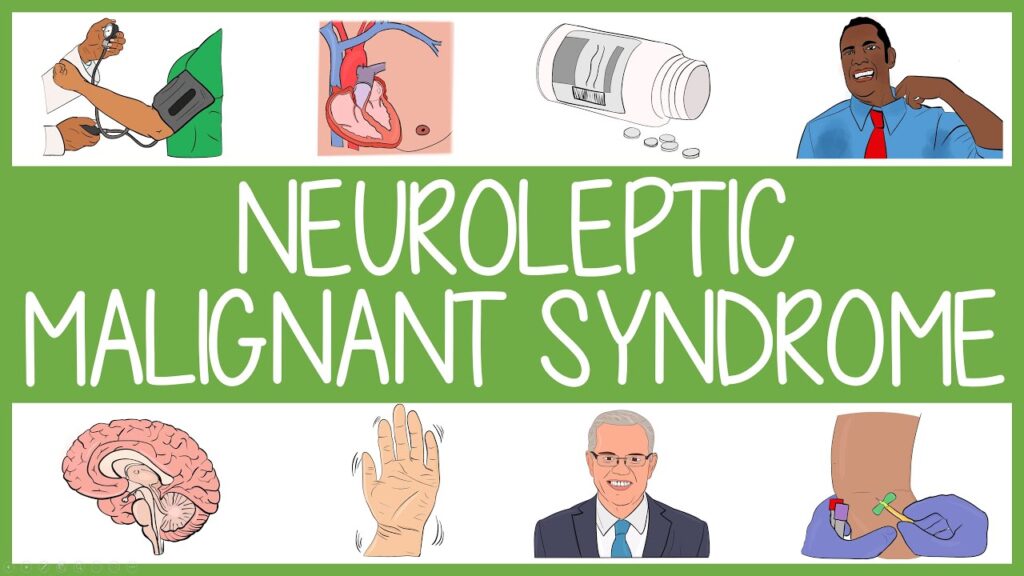Neuroleptic malignant syndrome (NMS) is a rare but life-threatening reaction to neuroleptic (antipsychotic) medications. It is characterized by fever, muscle rigidity, altered mental status, and autonomic dysfunction. NMS results from dopamine receptor blockade in the central nervous system, leading to dysregulation of body temperature, motor control, and autonomic function. Without prompt recognition and treatment, it can cause rhabdomyolysis, acute kidney injury, and multi-organ failure.

Pathophysiology of Neuroleptic Malignant Syndrome
The exact mechanism of NMS is not fully understood, but it primarily involves dopaminergic dysfunction in the basal ganglia and hypothalamus.
- Dopamine D2 receptor blockade in the central nervous system leads to impaired thermoregulation, autonomic instability, and muscle rigidity.
- Sustained muscle contraction results in hyperthermia and rhabdomyolysis.
- Autonomic instability causes fluctuations in blood pressure, heart rate, and respiratory function.
Causes and Risk Factors
1. Medications Associated with NMS
NMS is most commonly induced by dopamine-blocking agents, including:
- First-generation (typical) antipsychotics: Haloperidol, Chlorpromazine, Fluphenazine
- Second-generation (atypical) antipsychotics: Risperidone, Olanzapine, Clozapine
- Dopamine-depleting agents: Metoclopramide, Reserpine
- Abrupt withdrawal of dopamine agonists (e.g., Levodopa in Parkinson’s disease)
2. Risk Factors
- High doses or rapid dose escalation of neuroleptics
- Parenteral (intravenous or intramuscular) administration
- Pre-existing neurological disorders (e.g., Parkinson’s disease, brain injury)
- Dehydration and electrolyte imbalances
- Recent catatonia or agitation
Symptoms of Neuroleptic Malignant Syndrome
NMS typically develops within days to weeks after starting or increasing the dose of a neuroleptic medication.
1. Cardinal Symptoms
✅ Hyperthermia (Fever ≥ 38.5°C or 101.3°F) – Uncontrolled body temperature due to hypothalamic dysfunction.
✅ Severe muscle rigidity (“lead-pipe” rigidity) – Stiffness without tremor.
✅ Altered mental status – Confusion, agitation, delirium, or coma.
✅ Autonomic dysfunction – Fluctuations in heart rate, blood pressure, and respiratory rate.
2. Additional Symptoms
- Tachycardia (rapid heart rate)
- Hypertension or hypotension
- Diaphoresis (excessive sweating)
- Dysphagia (difficulty swallowing)
- Respiratory distress
Complications of Untreated NMS
If left untreated, NMS can progress to life-threatening complications, including:
❌ Rhabdomyolysis – Breakdown of muscle tissue, releasing myoglobin into the bloodstream.
❌ Acute kidney injury – Due to myoglobin-induced renal damage.
❌ Respiratory failure – Due to diaphragm rigidity.
❌ Seizures – Resulting from severe autonomic instability.
❌ Multi-organ failure – Due to persistent hyperthermia and systemic inflammation.
Diagnosis of Neuroleptic Malignant Syndrome
NMS is a clinical diagnosis based on history, symptoms, and laboratory findings. There is no specific confirmatory test.
1. Diagnostic Criteria
According to the DSM-5, NMS requires:
- Exposure to dopamine-blocking agents
- Severe muscle rigidity and hyperthermia
- Autonomic instability (e.g., tachycardia, diaphoresis, blood pressure fluctuations)
- Elevated creatine kinase (CK) levels (> 1,000 U/L)
2. Laboratory Findings
- Elevated CK and myoglobinuria – Indicate muscle breakdown.
- Leukocytosis (increased white blood cells) – Due to systemic inflammation.
- Elevated liver enzymes (AST, ALT) – Suggestive of muscle and organ damage.
- Metabolic acidosis – Due to lactic acid buildup.
3. Differential Diagnosis
NMS must be distinguished from serotonin syndrome, malignant hyperthermia, and severe catatonia.
| Feature | Neuroleptic Malignant Syndrome | Serotonin Syndrome | Malignant Hyperthermia |
|---|---|---|---|
| Onset | Days to weeks | Hours | Minutes to hours |
| Muscle Rigidity | Lead-pipe rigidity | Clonus and tremors | Generalized rigidity |
| Hyperthermia | Present | Present | Severe |
| Autonomic Dysfunction | Severe | Moderate | Severe |
| Drug Causes | Antipsychotics | SSRIs, MAOIs, MDMA | Anesthetic agents |
Treatment of Neuroleptic Malignant Syndrome
1. Immediate Discontinuation of Causative Agent
- Stop all dopamine-blocking medications immediately.
2. Supportive Care (Mainstay of Treatment)
- Aggressive cooling with ice packs and cooling blankets.
- IV fluids to prevent dehydration and kidney damage.
- Electrolyte correction (e.g., sodium, potassium, calcium).
- Oxygen therapy and mechanical ventilation if respiratory failure occurs.
3. Pharmacological Treatment
- Dantrolene: A direct skeletal muscle relaxant that reduces rigidity and hyperthermia.
- Bromocriptine or Amantadine: Dopamine agonists to counteract dopamine blockade.
- Benzodiazepines (e.g., Lorazepam): To manage agitation and muscle stiffness.
4. Dialysis and Intensive Care Management
- Hemodialysis or renal replacement therapy for acute kidney injury.
- ICU admission for continuous hemodynamic monitoring.
Prognosis and Prevention
1. Recovery and Outcomes
- With prompt treatment, mortality rates are reduced to <10%.
- Symptoms typically resolve within 1–2 weeks, but muscle weakness may persist longer.
2. Prevention Strategies
- Gradual titration of antipsychotic doses to minimize risk.
- Monitor high-risk patients closely for early symptoms.
- Avoid drug interactions that enhance dopamine blockade (e.g., lithium with antipsychotics).
Neuroleptic malignant syndrome is a severe and potentially fatal reaction to antipsychotic medications, caused by dopamine blockade leading to autonomic instability, hyperthermia, and muscle rigidity. Early diagnosis and immediate discontinuation of the offending agent, supportive care, and pharmacological interventions are crucial for survival. Increased awareness and careful medication management can help prevent NMS and improve patient safety.